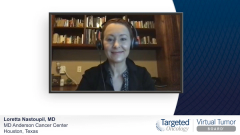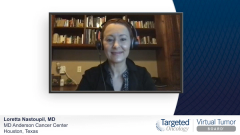
Case 1: Identifying Patients for CNS Prophylaxis in DLBCL
Kami Maddocks, MD:What about working up this patient? Is there any further workup? Is this a patient that you would consider looking for CNS [central nervous system] disease? And if so, how do you do that? Who do you do a baseline brain MRI? When are you thinking about CNS prophylaxis?
Loretta Nastoupil, MD:In our retrospective series of double-hit patients, not specific to double expressors, we found that the rate of CNS involvement was as high as 13%. Because we’re on the fence about how concerned we should be about double-hit features … we often will perform a diagnostic LP [lumbar puncture] to assess for circulating tumor cells. The timing of that, whether you add in prophylactic chemotherapy, depends on … the CNS IPI [International Prognostic Index], but also whether we’re concerned about the underlying disease histology and whether there are high-grade features. It’s reasonable in this case to perform at least a diagnostic LP and then consider prophylactic—either methotrexate and/or cytarabine.
Ian Flinn, MD, MPH: I agree. It’s hard to argue against getting an LP in this patient who had some high-risk features and then letting your results of the FISH [fluorescence in situ hybridization] my guide, whether I treat this patient prophylactically with either intrathecal chemotherapy or whether they were receiving … day high-dose methotrexate in order to prophylax against CNS involvement. I wouldn’t do a brain MRI. Unless a person had symptoms, that’s probably a low yield.
Kami Maddocks, MD: What types of patients are you doing prophylaxis besides double-hit patients?
Jason Westin, MD, MS, FACP: We have the CNS IPI, which is the regular IPI as well as looking at high-risk sites such as the adrenal gland or kidneys. We know that gonadal involvement does increase the risk, as does spinal disease if somebody has involvement of the bones and the spine, the sinuses if the bone marrow is involved. … As Dr Nastoupil mentioned, double-hit patients have up to 13%. We know that the higher the CNS IPI, it’s going to be up in the 20% risk of having occult disease. If you don’t address it with primary therapy, relapse in the brain is a bad problem. The CNS IPI is a useful shorthand tool to help decide what’s the risk and what’s the tradeoff cost-benefit ratio to give prophylactic therapy.
Kami Maddocks, MD: Dr Nastoupil had mentioned intrathecal methotrexate or cytarabine while waiting for FISH. Are there other things people are using for prophylaxis? Is there a standard agreement or approach?
Ian Flinn, MD, MPH: For patients that don’t have the double hit, and for which we’re using dose-adjusted R-EPOCH [rituximab, etoposide phosphate, prednisone, vincristine sulfate, cyclophosphamide, and doxorubicin hydrochloride], for a lot of our patients, such as … high-risk, adrenal gland involvement … we’ve switched over to using high-dose methotrexate incorporated with R-CHOP [rituximab, cyclophosphamide, doxorubicin hydrochloride, vincristine sulfate, and prednisone] regimen. And we do it different ways and I’m not sure there’s 1 right way, but we’ve been giving it on day 8 of R-CHOP chemotherapy. It’s very cumbersome. We must admit the patient to the hospital. No one likes doing this. But I think that you tend to get better penetration of the CNS and probably better prior distribution. We’ve switched over to doing that from giving intrathecal chemotherapy.
Kami Maddocks, MD: And when you use dose-adjusted R-EPOCH, do you incorporate that somehow into the treatment, or do you use the intrathecal with that?
Ian Flinn, MD, MPH: I’d love to hear how other people do it. We do the intrathecal just because I think it’s difficult to integrate methotrexate into that regimen. I know that at some centers they will take a break and then give high-dose methotrexate after several cycles of R-EPOCH. But we’ve been giving intrathecal in that patient population, but it sounds like the group at [The University of Texas] MD Anderson [Cancer Center] has a lot of experience in terms of retrospective analysis of your patient population.
Loretta Nastoupil, MD:We did do a small retrospective series looking at high-dose methotrexate mid-cycle with dose-adjusted EPOCH-R [rituximab, etoposide phosphate, prednisone, vincristine sulfate, cyclophosphamide, and doxorubicin hydrochloride], and it can be done. It can be done safely, albeit in our hands and a small series. But you bring up a good point in terms of the cytopenias that are likely to happen. How do you handle growth factors knowing that these patients are likely going to be neutropenic? It’s cumbersome and something that probably is not generalizable to everyone’s practice.
Kami Maddocks, MD: I think the important thing to remember when trying to do that is that if you’re giving the curative therapy, you don’t want to risk the curative component for the prophylactic component for that, that’s done right.
Transcript edited for clarity.















































